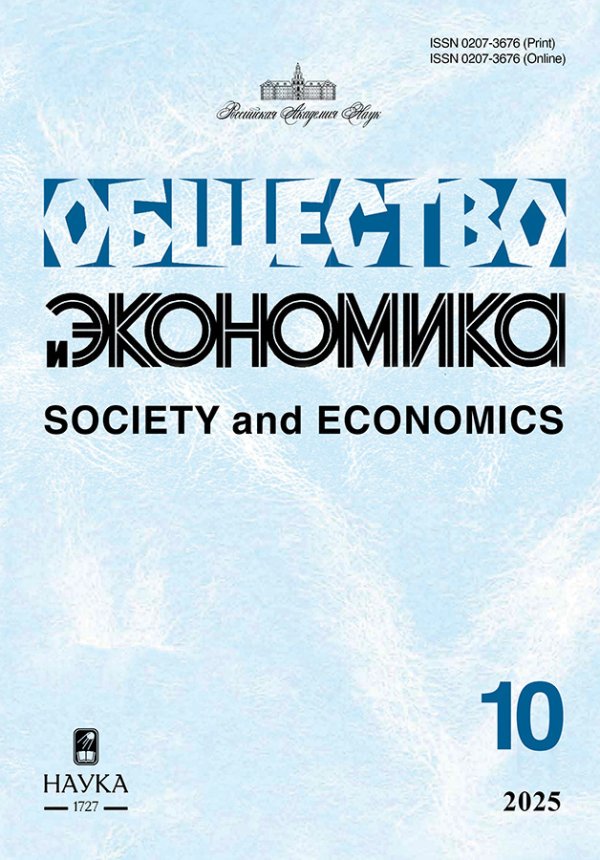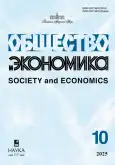No 10 (2025)
THEORETICAL ECONOMICS
WESTERN AND NON-WESTERN ECONOMIC WORLDS: MUTUAL REJECTION OR COMPLEMENTARITY?
Abstract
The article addresses the fundamental problem of coordinating the economic interests of countries with different social systems in the process of ongoing gradual globalization. The author considers the most well-known planetary projects while special attention is paid to the Sustainable Development project presented in Agenda-2030 and involving global transformation. The author substantiates the possibility of a scenario of mutual complementarities of the economies in Western and non-Western countries during the current decade. The main preconditions necessary for the fulfillment of this scenario are revealed. According to the arguments presented, the answer to the next neo-conservative challenge can be given by the implementation of a fundamentally updated strategy of sustainable development. The latter will make it possible to establish an inclusively fair world economic order and achieve a sustainable, albeit compromise, coordination of the interests of countries with different social forms of economic activity.
Society and Economics. 2025;(10):6-23
 6-23
6-23


ECONOMIC POLICY
INNOVATIVE DEVELOPMENT PROGRAMS OF STATE-OWNED COMPANIES AND THE POLICY OF TECHNOLOGICAL SOVEREIGNTY: IN SEARCH OF CONNECTIONS
Abstract
The article reflects the results of the study of conceptual and actual connections of innovative development programs (IDP) of Russian state-owned companies as an instrument of innovation policy and the main documents of strategic planning of scientific and technological policy (STP). The conceptual place and role of IDP in the system of goal-setting of STP are determined, the actual connections of IDP with STP documents in the period 2011-2022 are studied. It is revealed that the IDP have reflected the main provisions of STP documents at the national level and the underlying documents of the industry level once were almost completely absent. At the same time, in the strategic documents of STP for the period 2011–2022 the PIR tool was not officially defined at either the national or industry level. An exception was, for example, the Forecast of Scientific and Technological Development (S&T) of the fuel and energy complex of Russia for the period up to 2035, where the PIR was defined as a tool for developing the scientific and technological potential of the industry. A study of the modern outline of strategic documents on the policy of technological sovereignty shows the reflection of the PIR as the main tool for implementation, in the Strategy of the Scientific and Technological Revolution, the Concept of Technological Development and the Federal Law on Technological Policy.
Society and Economics. 2025;(10):25-37
 25-37
25-37


Thematic framework for research on transport infrastructure and economics: a systematic review of the literature using nlp
Abstract
This study presents a systematic analysis of 7,566 articles from international peer-reviewed journals on transport infrastructure and economic development. Using machine-learning and cluster-analysis techniques, it identifies the field’s key research directions. The results reveal four dominant thematic clusters: sustainable transport, digitalisation, regional corridors and decarbonisation. Topic-trend analysis shows a rapid surge of interest in the transition to alternative fuels (biofuels, hydrogen), carbon-footprint reduction and the deployment of digital solutions. China leads in both publication count and growth rate, while Russian research concentrates on developing transport corridors, including the Northern Sea Route. The most highly cited studies remain those with an environmental focus—particularly on CO₂-reduction efficiency and climate policy. The resulting thematic maps help uncover knowledge gaps and highlight priority research areas. Future work should include an in-depth analysis of regional specificities in transport transformation and an assessment of the long-term economic effects of environmental initiatives.
Society and Economics. 2025;(10):39-55
 39-55
39-55


SOCIAL ISSUES
Regional features of women’s employment in the informal sector of the Russian economy
Abstract
The relevance of the study is due to the growing scale of women’s participation in informal employment in Russia, which contradicts the goals of state policy to ensure gender equality and improve the quality of working life. The aim of the study is to identify regional characteristics of women’s employment in the informal sector of the Russian economy and to analyze the factors that determine its differentiation depending on the level of socio-economic development and the type of regional economy. The empirical base comprises microdata from the Labor Force Survey and the Comprehensive Survey of Living Conditions carried out by Rosstat. Six regions of Russia, differing in their level of economic development and sectoral structure, were selected for comparative analysis. The study used the methods of descriptive statistics, correlation analysis and a gender-sensitive approach to labor market analysis. The results obtained reveal significant regional differences in the scale and structure of female employment in the informal sector. An inverse relationship between the level of socio-economic development of the region and the scale of informal employment of women is confirmed. It is shown that women in the informal sector more often face insufficient social protection and employment instability, despite a high level of education. Regional differences are also significantly influenced by sociocultural factors. Informal employment is both a survival strategy and a source of flexibility for vulnerable categories of women. The need to develop regionally differentiated and gender-sensitive measures aimed at formalizing women’s employment and improving the quality of working life is identified.
Society and Economics. 2025;(10):57-75
 57-75
57-75


Economic Aspects of Migration from Uzbekistan, Tajikistan and Kyrgyzstan
Abstract
The article provides a comprehensive analysis of labor migration from the Central Asian countries – Uzbekistan, Tajikistan, and Kyrgyzstan – positioning it as a key socio-economic phenomenon that exerts a decisive influence on the economy, employment structure, migration flows to the Russian Federation, transformations over the past 25–30 years, geopolitical crises, and the tightening of migration control. Special attention is paid to the employment structure, demographic profile of migrants, their educational level, and legal status. The paper explores the diversification of migration routes and institutional efforts to organize legal employment abroad. The analysis reveals the need to improve migration policies and legal mechanisms for the protection of migrants. The article also addresses methods for the return and reintegration of migrants within the Central Asian republics through the revival of enterprises and organizations based on the use of local labor and mineral resources.
Society and Economics. 2025;(10):77-87
 77-87
77-87


WORLD ECONOMY
Digital transformation of the pharmaceutical industry in the USA and China: technological superiority and Russian prospects
Abstract
The article analyzes the main global trends and challenges of the ongoing digital transformation in modern pharmaceutical industry. The author highlights the specific approaches and key achievements in the development of the digital pharmaceutical sector in the United States and China, including their positions in the global market for digital technologies, the main components and outcomes of their national strategies for digital transformation, and projects based on Industry 4.0 and Pharma 4.0 concepts and their results. The prospects for digital transformation in Russia’s pharmaceutical industry in the context of new challenges are also assessed.
Society and Economics. 2025;(10):89-103
 89-103
89-103















